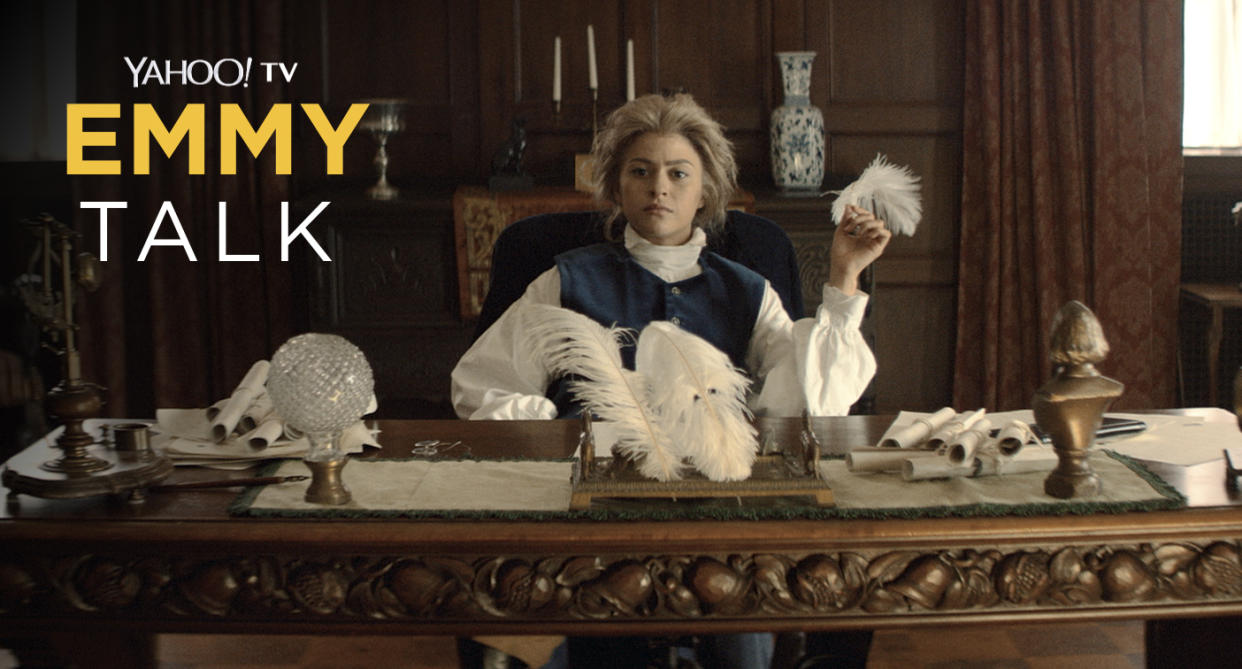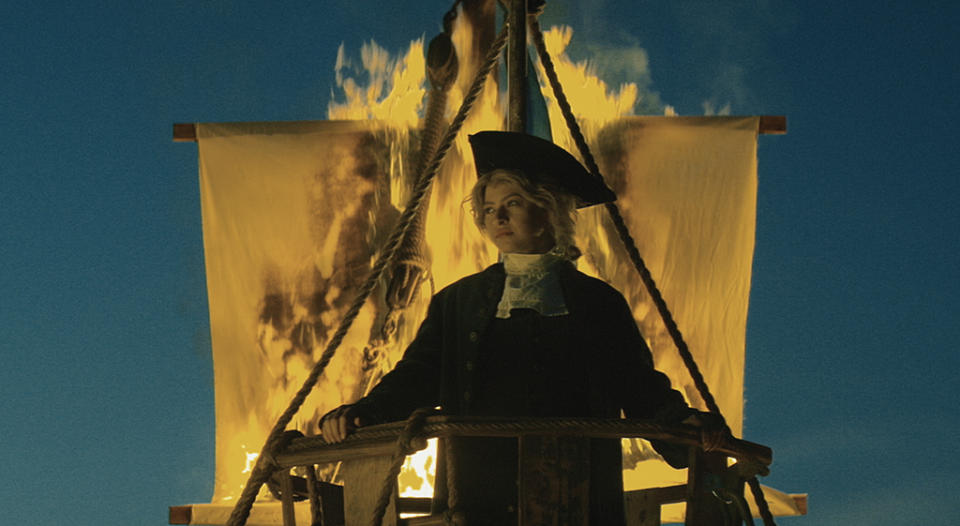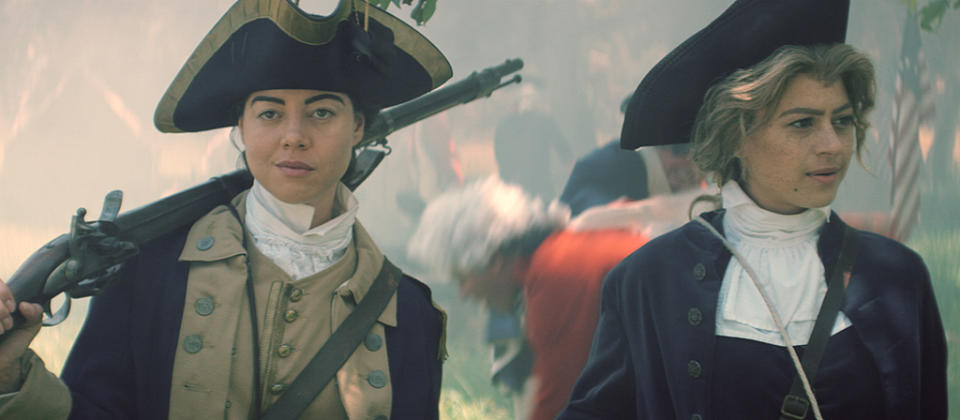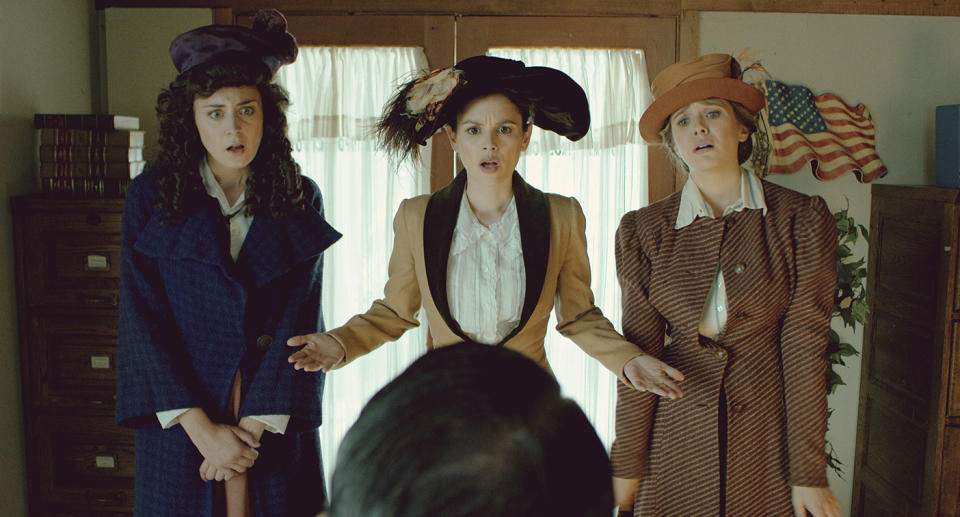'Drunk History': Emmy-nominated production designer on creating 'Hamilton' episode

The hilarity of Drunk History isn’t just in hearing celebrities drunkenly recount tales from the past, but watching their words match up to the reenactments as well.
The reenactments feature a ton of Hollywood stars — everyone from Octavia Spencer to Ed Helms to Aubrey Plaza to Liev Schreiber. But what also makes these scenes so funny is the production design, which includes amusing backdrops, quirky miniatures, and historically accurate props.
Production designer Chloe Arbiture received an Emmy nomination for her work in the Hamilton episode, which was narrated by the smash musical’s creator, Lin-Manuel Miranda. She chatted with Yahoo TV about the challenges of bringing Drunk History to life, from tight schedules to the Great Molasses Miniature Escapade.
Yahoo TV: First, can you describe how you approach every episode of Drunk History?
Chloe Arbiture: When I get a script from Drunk History, the first thing I do is look at all of the scene headings. That tells me where they want to put those scenes. In any script, it can be anywhere from eight to 15 scenes. I’ll make a list of where everything is going to take place and then sit down with the location manager, because we shoot on location.
For every episode of Drunk History there are three stories, and we have to think of how we’re going to group things. We want to make sure if the stories appear in the same episode, they aren’t shot in the same location so that, visually, it’s kind of broken up.
Before we really do any real research, we look at what our location availability is. And then we go into the research portion and say, this takes place here, so this location — let’s say it’s a hotel — could cover these five scenes and we can move outside for the scenes. It’s funny because it really starts with more logistics than creative.
What was it like doing the Hamilton episode, since that featured just the one story, not the usual three?
It’s our first and only standalone episode. When I got the script, I felt some pressure because Hamilton is such a popular musical and because our narrator was Lin-Manuel Miranda. We talked about how much we wanted to make it like the musical or how much we wanted to do our own version of it. I think that allusions to the musical are pretty inherent because the narrator was Lin-Manuel.
When I got that script, I think it ended up being 35 individual sets that we needed to go to. I did the same sort of process, but usually we shoot a story in one day, but with 35 sets, we had three shooting days, which is the most we’ve ever had.

We actually had it in two locations. For our interiors, we shot at the Wilshire Ebell in Los Angeles. For our exteriors, we shot at Golden Oak Ranch. But then we had to figure out how to structure those three days to get the most out of our locations. Also, we wanted to be able to tell some of the parts that they can’t do in the musical — for instance, the flaming ship. And we wanted to be true to Drunk History’s aesthetic, too. So I pushed for a miniature on that because (a) miniatures are awesome and (b) it’s such a Drunk History thing to do. Our directors, Jeremy [Konner] and Derek [Waters], said, “We’d love to do a version that’s life-size, where she’s standing on the crow’s nest and it’s burning,” so we ended up building that portion.
The episode incorporated all the Drunk History jokes, like we have a backdrop, we have miniatures, we have something on fire, we have anachronistic cellphone usage. It was similar to the musical, but also we wanted to do our own Drunk History storytelling with it.
How do you balance looking historically accurate and the comedy of it all?
In the art department — and I know this is true for costumes as well — we all actually aim for historically accurate. We always start with what was real. Because the comedy really comes in from the narrator; the jokes are already there. We do have to find a balance between being too silly and historically accurate.

I actually think the comedy is even funnier when it’s juxtaposed against really serious-looking historical images. We forget that people in history — we see these pictures of people in top hats and all buttoned up, and we think, oh, they must have been so serious. But I love the connection is that people throughout history have been silly creatures and the way we live our lives can be silly.
Do you build the miniatures and backdrops, or rent some of them?
The miniatures, I built those myself. It’s actually out of necessity because we move so fast. Hamilton was an exception, but like I said, we normally shoot one story per day. And oftentimes, I may only get 10 or 15 minutes to talk to Derek and Jeremy about what they want or what direction we want to go. So it really is born out of necessity that I’m the one making them, but I also love doing it. It’s like a bonus for me at my job.
In terms of the backdrops, we rent all of those. We do have a lot of custom scenery painted. In Season 4, in [Episode 10], the story was about the Cherry sisters, this group of sisters that were these terrible performers. We ended up painting a lot of the scenery for that. And in Season 5, which we just finished shooting, we have a lot more painted scenery that is custom-made. But it is fun to look through the inventory of what’s already been created and then build around what’s already there. Sometimes the jokes get even better sort of unintentionally because of what backdrops are available.

How do you source the props?
We have a pretty large set-dress crew. We rent things mostly from rental houses now. Obviously, all of the newspapers that have jokes or all the signs that have jokes — those are all fabricated by our team. We have a sign painter, and we have printers that we work with that will print newspapers for us. We have an in-house graphic designer. Like in Hamilton, there was a newspaper that said, “Hamilton is not a good dude” or whatever. That we obviously had to make.

What’s the biggest challenge in designing Drunk History?
I would say the schedule is really demanding. The people I work with — it’s such a collaboration, and the team that I have in place are just an amazing group of artists and they’re amazing collaborators, so that part is a dream come true. But the schedule can be really demanding. So we’ll shoot five stories in five days, and that’s five different time periods, and that could be 50 to 75 sets in a week.
Of course, you were nominated for the Hamilton episode, but is there some other episode you’re really proud of?
It was the second-to-last day of shooting on [Season 4, Episode 8] and I had pushed this scene off. I have a pretty big say in the order in which we shoot the stories. I had pushed this story off and pushed it off, and it was about the Great Molasses Flood in Boston at the turn of the century. This molasses tank that had millions of gallons of molasses burst and flooded a section of Boston and killed a bunch of people, and it was really terrible.

Jeremy Konner was directing that episode, and he was really set on showing a flooded downtown with molasses. I was like, “How are we going to do this?” So I ended up building this entire miniature of the North End of Boston. And it took me like 40 man-hours, which is the most time I’ve ever spent, ever, on a miniature. And we had one take to explode. We had one take for the special-effects person to explode a fake molasses container over this thing.

It was so stressful, but it ended up being hilarious. It was such a triumphant feeling. There was something awesome about spending all that time and then it’s gone. That’s the essence of what I do: I create a world, and then in two days it’ll be gone. And this was in an instant, all my work was gone. Because I built it myself and had no help, I think that’s why I was even more invested. Now, to me, it’s one of the most rewarding episodes, because it was worth it. It turned out exactly how we wanted, and it was, I think and I hope, the audience felt like it was funny.
The 69th Emmy Awards will air Sept. 17 at 8 p.m. on CBS.
Read more from Yahoo TV:
